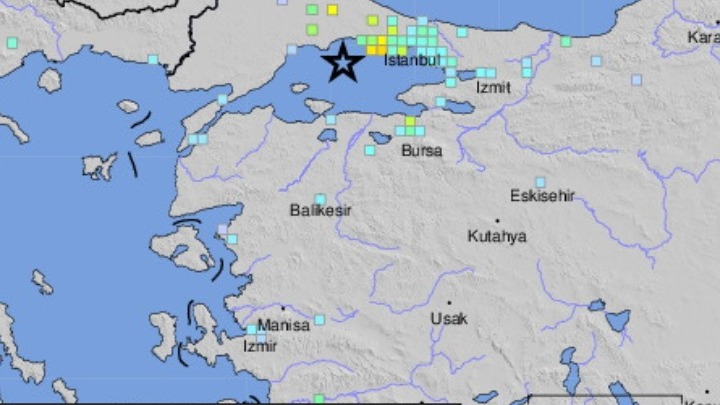Climate change has happened and is already here, scientists tell ANA

The evidence in the form of heatwaves, fires and floods is now overwhelming and leaves no room to doubt; climate change has already happened, and the climate crisis is here, scientists told the Athens-Macedonian News Agency on Saturday. Its results are higher temperatures, stronger winds and greatly reduced ground humidity that falls below 10 pct due to extended drought, all of which are the common features of devastating fires now burning in Greece, Spain, France and Portugal, and which are forecast to get worse.
According to physicist-meteorologist Thodoris Giannaros, a researcher at the National Observatory of Athens, humanity has failed to address the problem and the world is now facing the consequences:
“This is why we now talk of a climate crisis. Climate change is not something that is going to happen sometime in the future. It is already happening. It is happening now. People will continue to suffer its repercussions and unless we take drastic measures to adapt and moderate this, the severity of these consequences will become greater,” he said.
According to Giannaros, the temperature in Europe especially will continue to increase at a rate that exceeds the global average, while the number of very hot days have doubled or even tripled in Greece.
Professor Dominique Morvan at the University of Aix-Marseille, who studies the behaviour of fires, was equally pessimistic and noted that a variety of techniques need to be used to protect from fires, adding that fire-fighting aircraft are not a panacea.
Giannaros: “The data is overwhelming”
“The data that we now have at our disposal is overwhelming and leaves absolutely no room to doubt climate change. The average temperature in Europe has been rising sharply for at least 40 years, as the figures from the EU’s Copernicus Climate Change Service show. In the last five years, especially, the average temperature on the European continent is almost 2C higher than the equivalent measurement in the second half of the 19th century. This increase in temperature, in fact, is 1C higher than the equivalent increase recorded by the average temperature of our planet, showing that Europe is heating up more quickly than any other continent in the last 15 years. The observed heating is directly linked with the more frequent occurrence of hot episodes and/or heat waves, which are also marked by greater intensity and duration. More worrying, however, is the fact that based on the latest report of the IPCC, the temperature in Europe will continue to increase at a rate exceeding the equivalent for global average temperatures, while extreme temperatures will occur with ever increasing frequency and ever-increasing intensity, even in the more northern latitudes of the continent,” Giannaros said.
Regarding Greece, he said the available evidence pointed to a doubling or tripling of days when the temperature exceeded 37C in the last 30 years, (1991-2020) in comparison with most of the 20th century since 1901. Also sharply increased and up to four times more frequent in the last 30 years compared with the period from 1901 to 1990 was the incidence of heatwaves. With respect to the forecast for the future, the scientific community agrees that the frequency, intensity and duration of high temperatures and/or heatwaves will increase up until the year 2100.
Rainfall lessening
In addition to hotter weather, climate change also leads to a reduction of rainfall, with longer and more frequent periods of drought. This change was not as stark and clear-cut as the rise in temperatures, Giannaros noted, but while the total amount of annual rainfall was not greatly decreased, there were clear and worrying signs of an increase in the frequency and duration of periods of no or little rain. As he explained, this meant that the rain which fell was concentrated in a few episodes of rainfall of greatly increased and possibly extreme intensity, whereas the dry conditions at other times contributed to conditions that made it easy for forest fires to start, continue and spread. The period of intense rainfall, often accompanied by very strong winds, also increased the quantities of dead growth in forests that promoted fires, such as fallen branches, tree trunks, leaves and others.
According to Giannaros, the extreme heatwave currently affecting north-western Europe, which led to unprecedented temperatures exceeding 40C in the United Kingdom, as well as the destructive forest fires in the western Mediterranean, were linked to climate change.
“Climate change is not responsible for the fires. It is not climate change that starts fires but people (through negligence or arson), or nature in the form of lightning. Climate change, however, creates the necessary pyrometeorological mix (hot and dry and windy) so that any fire which starts can more easily grow and become potentially destructive,” Giannaros said.
This was because the intense heat and extended dry periods made the available combustible material in forests more likely to catch fire and to help it spread. In addition, the greater number of hot and dry nights reduced the so-called “night window” – when temperatures would normally drop and humidity increase – for getting fires under control.
Professor Morvan, an expert in fire issues in France, forecast that 2022 will be an extremely bad year for fires due to the lack of rain in the winter and spring.
“The vegetation is very dry everywhere and the repeated heat waves also contribute to an increase in the level of danger,” she said, citing reports from fire fighters that fires in Europe were more intense and often exceeded the ability of fire-fighting aircraft to put them out, which had an impact on buildings and the population.
Morvan said that more action to prevent such fires were needed by reducing the amount of combustible material, either through deliberate burning or other techniques, such as creating strips of land where the vegetation is changed to restrict fires, or through agricultural activity in areas at risk of fire.
The challenge was not simply to purchase more water-bombing planes or helicopters but to do more in the long-term to prevent fires by maintaining activities that lessened the fire load, as well as avoiding the construction of homes within forests. Overall, Morvan said, fighting fires was chiefly a problem of managing the landscape.
“I don’t think that the fires seen in Europe today can be considered Mega-fires in comparison with what is seen in Australia, Canada, Alaska, Russia and California. Even if these fires in Europe can be considered very big (because even aerial means have a limit to their effectiveness), their intensity is at least two to three times smaller than the very big fires seen, for example, in Australia,” Morvan added.
Source: amna.gr





